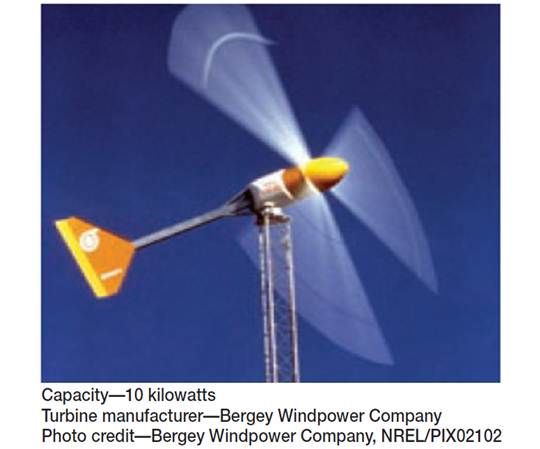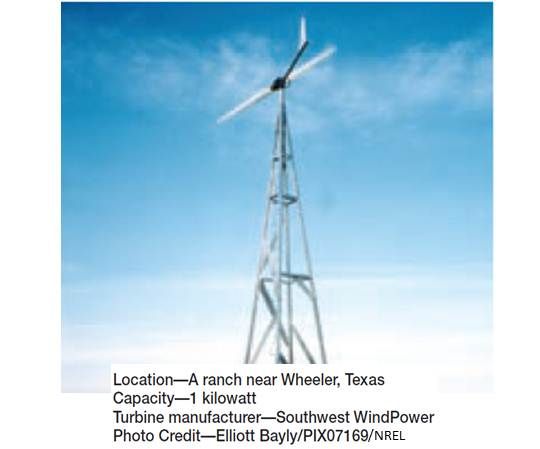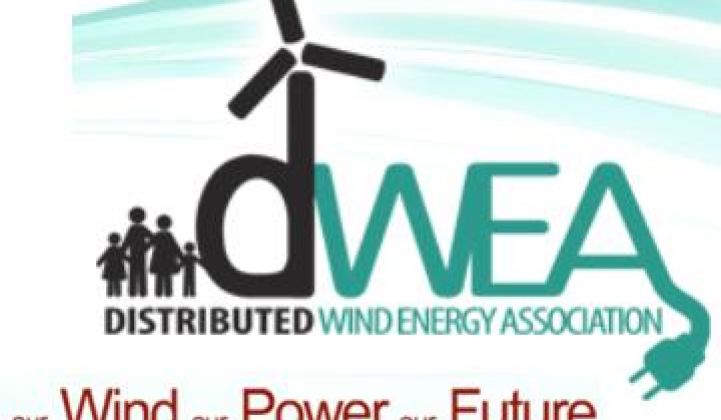Modern wind comes in three sizes: small, community, and utility-scale.
The first two constitute the new category of distributed wind, officially established with the formation of the Distributed Wind Energy Association (DWEA) last year.
This follows a larger renewables trend: the push for one-megawatt to twenty-megawatt projects that fall between rooftop scale and utility scale. A landmark 2010 University of California, Berkeley (UCB) study showed such projects could be the best way to build renewable capacity quickly because it avoids many permitting, interconnection, and NIMBY complications.
“The Distributed Wind Energy Association was formed to take up the cause of turbines of any size installed for the purpose of generating on-site electricity,” Jennifer Jenkins, the DWEA Executive Director, explained.
According to DWEA, small wind is defined as a turbine up to 100 kilowatts in nameplate capacity. Community wind consists of a turbine or turbines between 100 kilowatts and 1.5 megawatts in a project of less than 20 megawatts.
To be defined as community wind, a project must also be supported by a local governing body, owned by community members or must benefit the community. It can be larger than the UCB study’s definition of distributed energy if a third of it is owned by locals or those with stringently defined local interests.
The term 'utility-scale wind' applies to turbines over a megawatt in larger installations requiring hundreds of millions to billions of dollars in financing and years of permitting studies. Utility-scale installations usually require a transmission system interconnection that can take even longer to build than the wind project itself.

As the economy at large continued to struggle in recent years and utility-scale wind building fell off, distributed wind managed to sustain the momentum it developed during the 2005-2008 renewables expansion because of two strengths, Jenkins said.
First, distributed wind has the capacity to redirect its sales focus from one state to another. Unlike utility-scale wind and solar, “We had no federal tax credit incentives until 2009, so we had to learn to be nimble,” Jenkins said. “Our industry representatives learned to find the low-hanging fruit.” She added, “Our market is very resilient.”
What happened in California is an example, she said. As Greentech Media investigative pieces have reported, abuses of the taxpayer-funded emerging renewables program (ERP) forced the California Energy Commission (CEC) to suspend the program in mid-March of this year.
Suspension of the ERP significantly slowed distributed wind’s California business activity. According to the CEC, 249 rebate reservations for questionable systems, amounting to nearly $6.5 million, were approved but not paid, and 1,069 more rebate applications, totaling over $31 million, were put under review.
But, Jenkins said, the industry’s network of dealers and installers was able to shift its emphasis to states like Iowa where incentives for distributed wind remain strong.
Similarly, Jenkins said, the industry’s nimbleness allows it to identify and move quickly to take advantage of other kinds of opportunities. An example is the industry’s shift to rural markets and the Department of Agriculture’s Rural Energy for America (REAP) program.
REAP capped individual renewable energy system grants at $500,000, provided grants of as little as $2,500, and required that at least twenty percent of REAP funds go to grants of $20,000 or less. This effectively eliminated utility-scale projects from consideration but excited the interest of farmers familiar with windmills and somewhat skeptical of solar technology. The distributed wind industry quickly went after this group.
Based on feedback from distributed wind industry stalwarts such as Southwest Windpower and Bergey Windpower, Jenkins said, the industry’s 2010 performance statistics should reflect both shifts of emphasis and continued strength.
It is generally accepted, Jenkins said, that “those two companies are producing the most small wind turbines in the world.”
Jenkins said she had the impression Chinese small turbine manufacturers “are targeting the U.S. market” but that they “aren’t certified.” Though highly competitive pricing is allowing them to capture a large portion of available incentive programs, they “are not providing the efficiency or the energy” of U.S.-made turbines. Because of that, U.S. manufacturers are likely to hold on to much of the 95 percent of the market they owned in 2009, according to Jenkins.

Experimental vertical axis wind turbine (VAWT) designs continue to emerge, but the best performance still comes from the standard and familiar three-blade, horizontal axis wind turbine (HAWT) concept used by Southwest Windpower and Bergey Windpower. Prominent among emerging players are Endurance Wind Power and Northern Power Systems, both also makers of the three-blade HAWT design.
Among companies trying to crack the market with VAWT designs, Urban Green Energy and the U.K.’s Quiet Revolution draw approvals from most industry observers.
The biggest challenges facing the distributed wind sector, Jenkins noted, are the fixing of financial incentives, the standardizing of zoning codes and standards, and educating the public to understand there are alternatives to utility-scale wind.
But the potential to develop distributed wind power is enormous, Jenkins said, “if you look at rural America where folks live on a half-acre or more.” Estimates put the number of people on that much land, the generally recommended amount necessary for a smaller turbine, at as much as twenty million.
“It’s more than a green mindset,” Jenkins said. “People like controlling their utility bills, they like saving money on electricity and they like being energy independent.”
***
(This is the first in a three-part series about distributed wind. Next up are interviews with industry pioneers Bill Bergey of Bergey Windpower and Andy Kruse of Southwest Windpower; after that will come a look at emerging players and experimental designs.)



